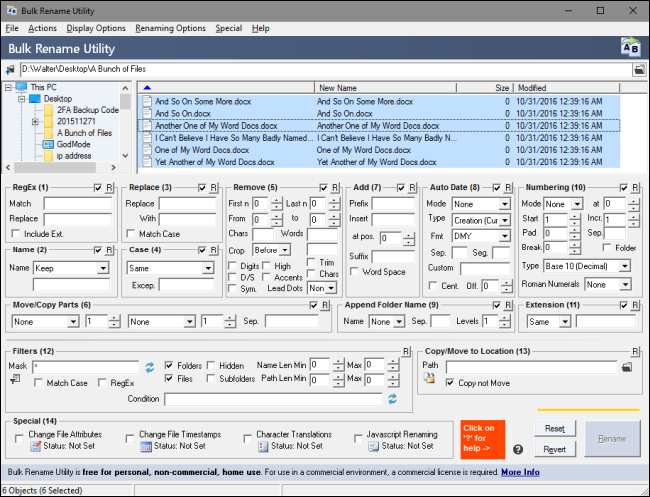

PowerShell Move File simple syntax. PowerShell Move file after confirmation. Move file and rename in the same script. People Also Search For: Select a few specific files using -match switch in PowerShell. PowerShell Move File: Here is the quickest syntax for moving a file in PowerShell. Please be sure to replace the source. Rename files with PowerShell. The Rename-Item cmdlet enables you to change the name of an object while leaving its content intact. It’s not possible to move items with the Rename-Item command; for that functionality, you should use the Move-Item cmdlet as described above. The following command renames a file.
Quite often I find myself having to rename a bunch of files in a folder, and what better way to do this than PowerShell? This simple one-liner is also a great way to learn a few new PowerShell tricks, or rather- get familiar with the syntax and see how flexible PowerShell is.
Rename Files and Folders with PowerShell Windows PowerShell is even more powerful and flexible than Command Prompt when it comes to renaming files and folders in a command-line environment. While we’ll only scratch the surface of naming your files, you can do some really powerful things, including piping cmdlets together to batch replace. The Rename-Item cmdlet changes the name of a specified item. This cmdlet does not affect the content of the item being renamed. You can't use Rename-Item to move an item, such as by specifying a path together with the new name. To move and rename an item, use the Move-Item cmdlet. Examples Example 1: Rename a file. Option 1: Using Windows PowerShell. Open the windows menu. Type: 'PowerShell' and open the 'Windows PowerShell' command window. Goto folder with desired files: e.g. Cd 'C:house chores' Notice: address must incorporate quotes ' if there are spaces involved. You can use 'dir' to see all the files in the folder.
The script I’m working on is rather long, and not finished, so for now I’ll just share this handy little snippet.
To rename all my files in a folder called blog I navigate to the folder in question and wrote this in PowerShell

Skype 8 52 0 138 percent. powershell_rename_files_numbers
$nr = 1
Dir | %{Rename-Item $_ -NewName (‘MyFile{0}.txt’ -f $nr++)}
Let’s walk through everything in those lines!
$nr = 1
Sets a variable called nr with the value of 1
Dir

is the content of current directory , unless path is specified as –path like so:
Dir -path C:UsersIrisDanielaPicturesBlog| %{Rename-Item $_ -NewName (‘File{0}.txt’ -f $nr++)}
https://uliribher1970.mystrikingly.com/blog/call-of-duty-black-ops-4-for-mac-free-download. You could also use Get-ChildItem (gci) or ls
|
Pipe will pass the output from the previous function to whatever we call next
% { }
does a foreach
Rename-Item
renames the item
-NewName
is where we define the new name
()
Is used here for grouping since the -NewName expects one input of type string
{0}
Copyclip 2 clipboard manager 2 9 3. is used for formatting as in C# together with
-f
Whatever we define after -f will replace {0}
You can have {0}{1} and so on, just separate the strings after -f with a comma like so: -f “I’m firs”, “I’m second”
++
is an increment operator, and here it will increment the $nr variable
Gimp 2 8 free download for pc. What the line above is saying is:
I want the start number to be one, and for each item in this directory I want to rename the item with a new name that is MyFile{some number}.text and incrementing the number so we can name the files MyFile1.txt, MyFile2.txt until we have gone through all the items
Autodesk inventor mac. Last modified on 2013-12-14
How many times have you wanted to rename files en-masse? Windows Explorer has a couple of great utilities to help with this task. For instance:
This is great, until you want to rename files in different folders to the same name. For example:
– Root
| – Folder 1
| | – File 1.txt
| | – File 2.txt
| | – File n.txt
| – Folder 2
| | – File 1.txt
| | – File 2.txt
| | – File n.txt
| – Folder 3
| | – File 1.txt
| | – File 2.txt
| | – File n.txt
Here, the normal multi-select isn’t possible, even if you perform a search. Instead, a quick PowerShell command lets us find and rename files in these subfolders.
Jumpstart 2nd grade for mac. Find the files in subfolders:
get-childitem -recurse -filter “File 1.txt” | foreach { $_.fullname}
This will display the full path of each file that you want to rename. Once you’re happy, pipe the results into the rename-item cmdlet:
get-childitem -recurse -filter “File 1.txt” | foreach {rename-item -path $_.fullname -newname “Renamed File 1.txt”}
This will search the current folder and subfolders, rename any files called ‘file 1.txt’ to ‘renamed file1.txt’ Contour 2 1 2.
